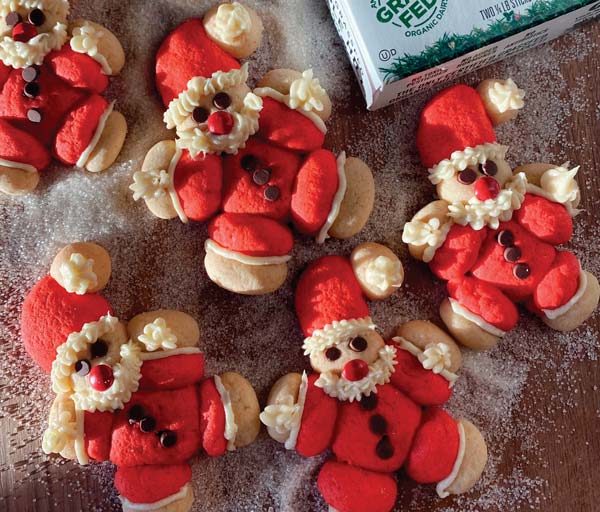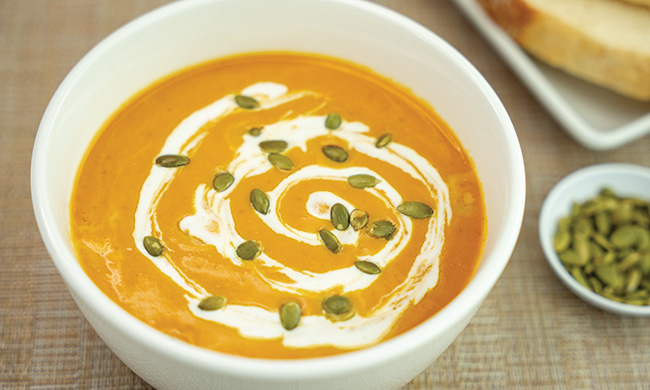Foodie News
Six Simple Summer Sides
Last Updated on June 5, 2024 by Daily News Staff
ATLANTA /PRNewswire/ — Hot temps call for cool sides and Chef Virginia Willis offers six simple summer side dishes that are perfect for parties or easy suppers at home. Your family and guests will love these creative and light recipes that draw on fresh seasonal ingredients to bring a bright new dimension to the table. 

“Each of these recipes takes a half hour or less to make and most can be made ahead for easy entertaining. Healthy, fresh ingredients have played a key role in the 65-pound weight loss I’ve maintained for more than a year, but I’m not afraid to cave to cravings once in a while. Friends appreciate a table that includes healthful options, but they also love decadent treats, and a party is the perfect place to splurge!” said Virginia.
“Real-life recipes” are a Chef Virginia Willis hallmark. You’ll find all the ingredients at your local grocery store and the dishes are quick and easy to prepare. Ready to celebrate the season? Here you go! All recipes listed below are available on Virginia’s blog along with fabulous photos of how to present them at the table.
- Tomato Ginger Green Beans – Big, bold flavors of ginger and jalapeño partner with green beans for a side dish that can be served hot, warm or chilled.
- Air Fryer Greek Feta Fries– Who needs soggy takeout? This showstopper seems indulgent, but with 80% less fat than the deep-fried version.
- Creamed Corn Stuffed Tomatoes– Two of summer’s most delicious ingredients pair up with savory herbs, fresh peppers and creamy cheese.
- Baked Zucchini Chips– Good and good for you zucchini crisps are a great summer side dish- if they make it to the table!
- Peach and Tomato Gazpacho– This chilled soup is so good you might want to splash it with vodka and turn it into a cocktail.
- Small Bake Almond Crusted Baked Peaches – You won’t believe the secret ingredient that amps up the peach flavor.
All Recipes magazine is launching a Simple Sides column by Virginia, and you’ll see creative new recipes in every issue. Chef Virginia Willis shares recipes, culinary inspiration and lots of inside scoop on cooking and food on her Cooking with Virginia blog.
About Chef Virginia Willis
Virginia Willis is a French-trained chef, Food Network Kitchen talent, James Beard award-winning cookbook author, television personality, content creator, and social media influencer. She is the author of seven cookbooks including the James Beard Award-winning cookbook, Lighten up Y’all. She has appeared on Food Network’s Chopped, CBS This Morning, Fox Family and Friends, Martha Stewart Living, and as a judge on Throwdown with Bobby Flay. She is the former TV kitchen director for Martha Stewart Living, Bobby Flay, and Nathalie Dupree.
Virginia has been featured in the New York Times, the Washington Post, People Magazine, Eater, and Food52 and has contributed to Eating Well, Garden & Gun, Bon Appétit, and more.
Virginia’s followers and fans love her down-to-earth attitude, approachable spirit, and traveling exploits. Read all about her on VirginiaWillis.com.
SOURCE Virginia Willis Culinary Enterprises, Inc
At our core, we at STM Daily News, strive to keep you informed and inspired with the freshest content on all things food and beverage. From mouthwatering recipes to intriguing articles, we’re here to satisfy your appetite for culinary knowledge.
Visit our Food & Drink section to get the latest on Foodie News and recipes, offering a delightful blend of culinary inspiration and gastronomic trends to elevate your dining experience.
https://stmdailynews.com/category/food-and-beverage
You can also find food and beverage-related videos on our YouTube channel, where we regularly post new content and share tips, recipes, and demonstrations. https://youtube.com/playlist?list=PLEhXBupt8tVynuUhpQZMxQt4lvPmOiAtQ&si=InDwc7YaB0KIwmxy
Sign up for our STM & Coffee newsletter and get the latest food-related news and recipes directly into your inbox, ensuring you never miss out on exciting culinary trends, tips, and delicious inspirations.
Discover more from Daily News
Subscribe to get the latest posts sent to your email.
Food and Beverage
Unwrap the Holidays: Whataburger Launches 12 Days of Whatacheer With Daily App Deals
Celebrate the holidays with Whataburger’s 12 Days of Whatacheer! Discover daily in-app deals, exclusive to Rewards members, from December 12–23. Unwrap new menu favorites, BOGO offers, and festive savings—only on the Whataburger App.
12 Days of Whatacheer: Festive Deals for Rewards Members
How It Works
- Who: Whataburger Rewards members (sign up in the app if you’re not already!)
- When: December 12–23, with a new offer every day
- How: Open the Whataburger App, claim the day’s deal, and enjoy with your next order
Holiday-themed graphic reading ‘12 Days of WhataCheer’ on a red background with white dots. Below the text are images of Whataburger menu items: a Cinnamon Roll, Onion Rings, a Whataburger, a Whatafresher, a Honey Butter Chicken Biscuit, and a Strawberry Shake.
Why Join the Whataburger Rewards Fun?
Get Started
Discover more from Daily News
Subscribe to get the latest posts sent to your email.
Recipe of the Week
Holiday Desserts Just Got a Dairy-Forward Upgrade
Holiday Desserts: From festive cookies to indulgent dips, these delicious desserts bring people together to create memories that will last a lifetime. If you’re looking to impress guests, Santa Cookies are the ultimate treat. For a unique twist, try Gingerbread Dip, featuring vanilla Greek yogurt made with 100% grass-fed organic milk.
Last Updated on December 17, 2025 by Rod Washington

Holiday Desserts Just Got a Dairy-Forward Upgrade
(Family Features) Holiday desserts set the stage for seasonal delight and add a touch of joy to gatherings. From festive cookies to indulgent dips, these delicious desserts bring people together to create memories that will last a lifetime. If you’re looking to impress guests, Santa Cookies are the ultimate treat. Made with Maple Hill Salted Butter, they’re rich, soft and full of festive spirit. For a unique twist, try Gingerbread Dip, featuring vanilla Greek yogurt made with 100% grass-fed organic milk. Whether you’re hosting or deciding what to bring to the potluck, Maple Hill’s 100% grass-fed organic dairy makes it easy to whip up desserts that are as wholesome as they are delicious. Rich in nutrients and free from GMOs, hormones and antibiotics, each product comes from farms that prioritize regenerative practices as nature intended. With a 40% healthier ratio of omega 3:6 and 40% higher levels of CLA fatty acids compared to traditional organic dairy, you can feel good about sweet treats at the holiday table. To find more recipes, visit MapleHill.com.
Santa Cookies
Yield: 14 cookies- 1 cup (2 sticks) Maple Hill Salted Butter, at room temperature
- 1/2 cup brown sugar
- 1 tablespoon vanilla extract
- 1 large egg, at room temperature
- 2 1/4 cups all-purpose flour
- 1/4 teaspoon salt
- 1 teaspoon red food coloring
- mini chocolate chips
- mini red chocolate-coated candies
- 1/2 cup (1 stick) Maple Hill Salted Butter, at room temperature
- 4 ounces cream cheese, at room temperature
- 1 teaspoon vanilla extract
- 2 1/2 cups powdered sugar
- Preheat oven to 350 F and line two baking sheets with parchment paper.
- In large mixing bowl, beat butter, sugar and vanilla until light and fluffy. Add egg and beat until combined. Add flour and salt; mix until dough begins to form ball.
- Remove 1 cup dough and set aside. Add red food coloring to remaining dough.
- From red cookie dough, make one 1-inch ball and five 1/2-inch balls. From plain cookie dough, make one 3/4-inch ball and five 1/4-inch balls.
- On prepared baking sheet, place red 1-inch ball and gently flatten until 1/2-inch thick. Attach four red 1/2-inch balls for arms and legs. Attach plain 3/4-inch ball for head and gently flatten until 1/2-inch thick. Attach plain 1/4-inch balls for hands and feet. Shape remaining red 1/2-inch ball into triangle for hat and attach. Repeat with remaining dough, arranging cookies 2 inches apart on baking sheet. Add chocolate candies for eyes and buttons.
- Bake 12-15 minutes, or until lightly golden.
- To make frosting: In medium bowl, beat butter and cream cheese until light and fluffy, about 3 minutes. Add vanilla and powdered sugar; mix until combined.
- To decorate: Place half of frosting in piping bag with small tip to line Santa’s arms and legs. Place other half in second piping bag with small star tip to add Santa’s beard, hat and hands. Put small dot of icing between eyes and beard and place red mini chocolate-coated candy on face for nose.

Gingerbread Dip
Servings: 8-12- 4 ounces cream cheese, at room temperature
- 1/4 cup brown sugar
- 1/4 cup powdered sugar
- 3 tablespoons molasses
- 1 container (16 ounces) Maple Hill Vanilla Greek Yogurt
- 1 teaspoon ground ginger
- 1 teaspoon ground cinnamon
- 1 teaspoon ground nutmeg
- 2 cups whipped cream
- graham crackers
- fruit
- In medium bowl using electric mixer on medium speed, beat cream cheese and sugars about 1 minute. Add molasses and mix until combined.
- Add Greek yogurt, ginger, cinnamon and nutmeg; beat until combined. Fold in whipped cream and mix until fully incorporated. Refrigerate 1 hour before serving or overnight.
- Serve with graham crackers and fruit.
At our core, we at STM Daily News, strive to keep you informed and inspired with the freshest content on all things food and beverage. From mouthwatering recipes to intriguing articles, we’re here to satisfy your appetite for culinary knowledge.
Visit our Food & Drink section to get the latest on Foodie News and recipes, offering a delightful blend of culinary inspiration and gastronomic trends to elevate your dining experience. https://stmdailynews.com/food-and-drink/
Discover more from Daily News
Subscribe to get the latest posts sent to your email.
Food and Beverage
Usher in Cool Weather with Easy Pumpkin Soup
Pumpkin may be a classic fall flavor, but there’s no reason you can’t satisfy your craving for savory comfort foods all year long. Its smooth, creamy texture is a go-to ingredient for a variety of recipes, including this heartwarming and simple easy Pumpkin Soup.

Usher in Cool Weather with Easy Pumpkin Soup
(Family Features) Pumpkin may be a classic fall flavor, but there’s no reason you can’t satisfy your craving for savory comfort foods all year long. Forget spiced latte; with its wholesome nutrition and plenty of earthy flavor, pumpkin is the perfect ingredient for all kinds of flavorful dishes. It may inspire a warm, fall feeling but it’s much more than a seasonal product. Pumpkin puree can be enjoyed all year long mixed into your favorite baked goods, stirred into chilis or even scooped into your morning smoothie. The smooth, creamy texture of Green Giant 100% Pure Pumpkin, made in the United States with premium quality in mind, is a go-to ingredient for a variety of recipes, including this heartwarming and simple Pumpkin Soup. Simply simmer the pumpkin puree with coconut cream, vegetable stock, garlic and ginger for a soup that is comfort in a bowl. Explore new ways to enjoy seasonal recipes at greengiantvegetables.com.Watch video to see how to make this recipe!
 Pumpkin
Soup Cook time: 10 minutes
Servings: 4
Pumpkin
Soup Cook time: 10 minutes
Servings: 4- 1 can (15 ounces) Green Giant 100% Pure Pumpkin
- 1/2 cup coconut cream
- 1 cup vegetable stock
- 1 tablespoon garlic paste or 1 teaspoon garlic powder
- 1 tablespoon ginger paste or 1 teaspoon ground ginger
- salt, to taste
- pepper, to taste
- coconut rice, for serving (optional)
- bread, for serving (optional)
- In saucepan over medium heat, combine pumpkin, coconut cream, vegetable stock, garlic, ginger and salt and pepper, to taste. Stir until well incorporated, cook 10 minutes.
- Serve over coconut rice or with bread, if desired.
The fate of Lucky Supermarkets in SoCalLink: https://stmdailynews.com/the-fate-of-lucky-supermarkets-in-socal/
Discover more from Daily News
Subscribe to get the latest posts sent to your email.

